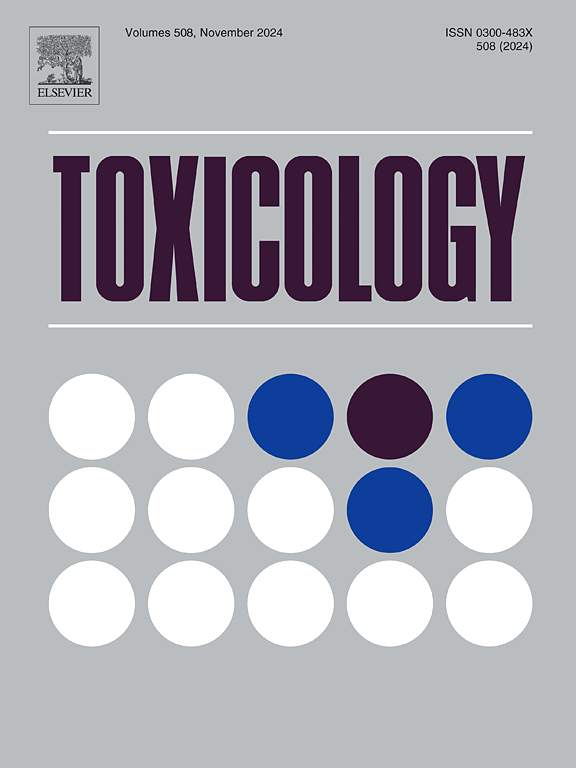雄性青春期大鼠通过聚合植入物亚急性暴露于2,2',5,5'-四氯联苯-4-醇导致大脑基因表达变化和血清代谢组学破坏。
IF 4.8
3区 医学
Q1 PHARMACOLOGY & PHARMACY
引用次数: 0
摘要
多氯联苯(PCBs)由于其持久性和不断从遗留和新出现的来源释放,仍然是一个环境健康问题。2,2',5,5'-四氯联苯(PCB52)是环境和人体血液中经常检测到的PCB同系物,被氧化成2,2',5,5'-四氯联苯-4-醇(4-52)。这种羟基化(OH-PCB)代谢物的神经毒性仍然不清楚。在这项研究中,我们将4周龄雄性Sprague Dawley大鼠通过植入皮下腔的聚合物植入药物输送系统暴露于4-52中,植入物中4-52的浓度分别为0%、1%、5%和10% (w/w),持续28天。对血清进行代谢组学分析。利用RNA测序、免疫荧光和多巴胺(DA)测量以及电化学检测来表征4-52对纹状体和小脑的影响,这些大脑区域与PCB神经毒性有关。血清代谢组学分析显示,4-52暴露后,“精氨酸生物合成”途径被破坏。暴露于4-52导致了与“氧化磷酸化”和“神经活性配体-受体相互作用”相关的途径中适度的转录组变化。免疫荧光显示小胶质细胞、星形胶质细胞或凋亡生物标志物无明显改变。在中剂量组,纹状体中DA代谢物DOPAL(3,4-二羟基苯乙醛)水平显著降低。随后的多组学网络分析确定了oh -多氯联苯、内源性代谢物和转录组之间的相互作用。例如,谷氨酸、天冬氨酸、胆碱和甘油磷胆碱的水平与纹状体中的4-52呈负相关。热休克蛋白(HSP)家族基因Hsp90b1、Hspa8、Hspa5的表达水平与脯氨酸、1-甲基胍、蛋氨酸亚砜等血清代谢物呈正相关。这些发现确定了4-52诱导的神经毒性的新生物标志物和靶点。本文章由计算机程序翻译,如有差异,请以英文原文为准。
Subacute exposure of male adolescent rats to 2,2′,5,5′-tetrachlorobiphenyl-4-ol via a polymeric implant causes gene expression changes in the brain and metabolomic disruption in serum
Polychlorinated biphenyls (PCBs) remain an environmental health concern due to their persistence and ongoing release from legacy and emerging sources. 2,2′,5,5′-Tetrachlorobiphenyl (PCB52), a PCB congener frequently detected in the environment and human blood, is oxidized to 2,2′,5,5′-tetrachlorobiphenyl-4-ol (4−52). The neurotoxicity of this hydroxylated (OH-PCB) metabolite remains poorly characterized. In this study, we exposed 4-week-old male Sprague Dawley rats to 4–52 via a polymeric implant drug delivery system grafted in the subcutaneous cavity at 4–52 concentrations of 0 %, 1 %, 5 %, and 10 % in the implant (w/w) for 28 days. Metabolomic analyses were performed in the serum. RNA sequencing, immunofluorescence, and dopamine (DA) measurement with electrochemical detection were used to characterize the effects of 4–52 on the striatum and cerebellum, brain regions implicated in PCB neurotoxicity. Serum metabolomic analysis revealed disruptions in the "arginine biosynthesis" pathway following 4–52 exposure. Exposure to 4–52 caused moderate transcriptomic changes in pathways related to "oxidative phosphorylation" and "neuroactive ligand-receptor interactions." Immunofluorescence showed no significant alterations in microglial, astrocytic, or apoptotic biomarkers. In the medium dose group, the levels of the DA metabolite DOPAL (3,4-dihydroxyphenylacetaldehyde) were significantly reduced in the striatum. Subsequent multi-omics network analysis identified interactions among OH-PCBs, endogenous metabolites, and the transcriptome. For example, levels of glutamic acid, aspartic acid, choline, and glycerophosphocholine negatively correlated with 4–52 in the striatum. Expression levels of heat shock protein (HSP) family genes, Hsp90b1, Hspa8, and Hspa5, positively correlated with serum metabolites, including proline, 1-methylguanidine, and methionine sulfoxide. These findings identify novel biomarkers and targets of 4–52-induced neurotoxicity.
求助全文
通过发布文献求助,成功后即可免费获取论文全文。
去求助
来源期刊

Toxicology
医学-毒理学
CiteScore
7.80
自引率
4.40%
发文量
222
审稿时长
23 days
期刊介绍:
Toxicology is an international, peer-reviewed journal that publishes only the highest quality original scientific research and critical reviews describing hypothesis-based investigations into mechanisms of toxicity associated with exposures to xenobiotic chemicals, particularly as it relates to human health. In this respect "mechanisms" is defined on both the macro (e.g. physiological, biological, kinetic, species, sex, etc.) and molecular (genomic, transcriptomic, metabolic, etc.) scale. Emphasis is placed on findings that identify novel hazards and that can be extrapolated to exposures and mechanisms that are relevant to estimating human risk. Toxicology also publishes brief communications, personal commentaries and opinion articles, as well as concise expert reviews on contemporary topics. All research and review articles published in Toxicology are subject to rigorous peer review. Authors are asked to contact the Editor-in-Chief prior to submitting review articles or commentaries for consideration for publication in Toxicology.
 求助内容:
求助内容: 应助结果提醒方式:
应助结果提醒方式:


